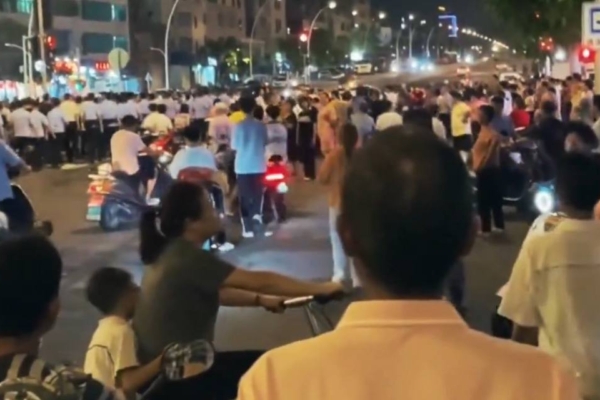On the early morning of May 7th, over a thousand villagers from Guang’ao Village in Haojiang District, Shantou City, Guangdong Province, blocked the road to protest against the local government’s attempt to forcibly move all fishing boats parked in the sheltered harbor out of the area. A large number of police forces were sent to the scene to suppress the protest, leading to physical confrontations and the detention of multiple villagers.
One of the villagers, Chen Mingjian (pseudonym), recounted the sequence of events to a reporter from the Epoch Times. Guang’ao Village has a former river sheltered harbor where villagers dock their fishing boats, and in 2019, a new sheltered harbor was built. Chen revealed that the new sheltered harbor was not constructed according to the planned blueprints, had weak sheltering abilities with many hidden reefs, posed safety risks, and could not accommodate over six hundred fishing boats owned by the villagers. The former sheltered harbor was recognized by the villagers as a safe and high-quality harbor, having withstood multiple typhoons over the years with the boats inside remaining unscathed. Consequently, for over a decade, the villagers were reluctant to move their boats out of the former sheltered harbor.
In October 2024, the villagers sought explanations from the village committee regarding the safety issues at the new sheltered harbor, requesting the local government to address the concerns. However, the local government did not take any action to resolve the matter. Unexpectedly on May 6th, a large number of police forces were dispatched by the local government to forcefully relocate the fishing boats.
Chen Mingjian described that around 3 pm on May 6th, many villagers gathered on the main road in front of the port, with the number increasing rapidly to a peak of one to two thousand people. The villagers had assembled to prevent the fishing boats from being towed to a temporary sheltered harbor in a neighboring village, which was ineffective during rough weather conditions. Moreover, incidents of theft of items from boats and cutting of cables frequently occurred at the temporary sheltered harbor.
According to Chen, the villagers continued to block the road to safeguard their rights until around 4 am on May 7th when a couple of hundred riot police arrived to disperse the villagers. A physical clash ensued between the two sides, resulting in injuries to some villagers and the detention of several individuals.
Chen Mingjian further mentioned that besides the issues related to the sheltered harbor, the primary cause of the villagers’ road-blocking protest was the sale of the village’s land over the past decade without transparency. Villagers were unaware of who the land was sold to and where the proceeds went. Additionally, the villagers had not received any dividends for decades, leading to a culmination of dissatisfaction among the villagers, resulting in the gathering of one to two thousand people to protest and protect their rights.
Around 9 am on May 7th, a group of over ten villagers attended a meeting with the village committee and the district party secretary, where Chen Mingjian and other villagers raised concerns about resolving the safety issues at the sheltered harbor, relocating it, and ensuring transparency in the land transactions, seeking accountability.
Chen revealed that during the meeting, the district party secretary promised to address the issues raised, but the subsequent actions and outcomes remained uncertain.
Guang’ao Village (Guang’ao Community) is a large village with a history of nearly 300 years, with a total population of 14,748 residents, out of which 14,277 are permanent residents. It is a major fishing community, with marine fishing being the primary economic activity, engaging over 2,000 people in operations such as trawling, spearfishing, fixed net fishing, bird ploughing, and reef enclosures. This sector also stimulates the development of seafood processing, sales, supply, transportation, fishing equipment maintenance, employing approximately 1,000 individuals and contributing over 65% of the community’s economic income.

